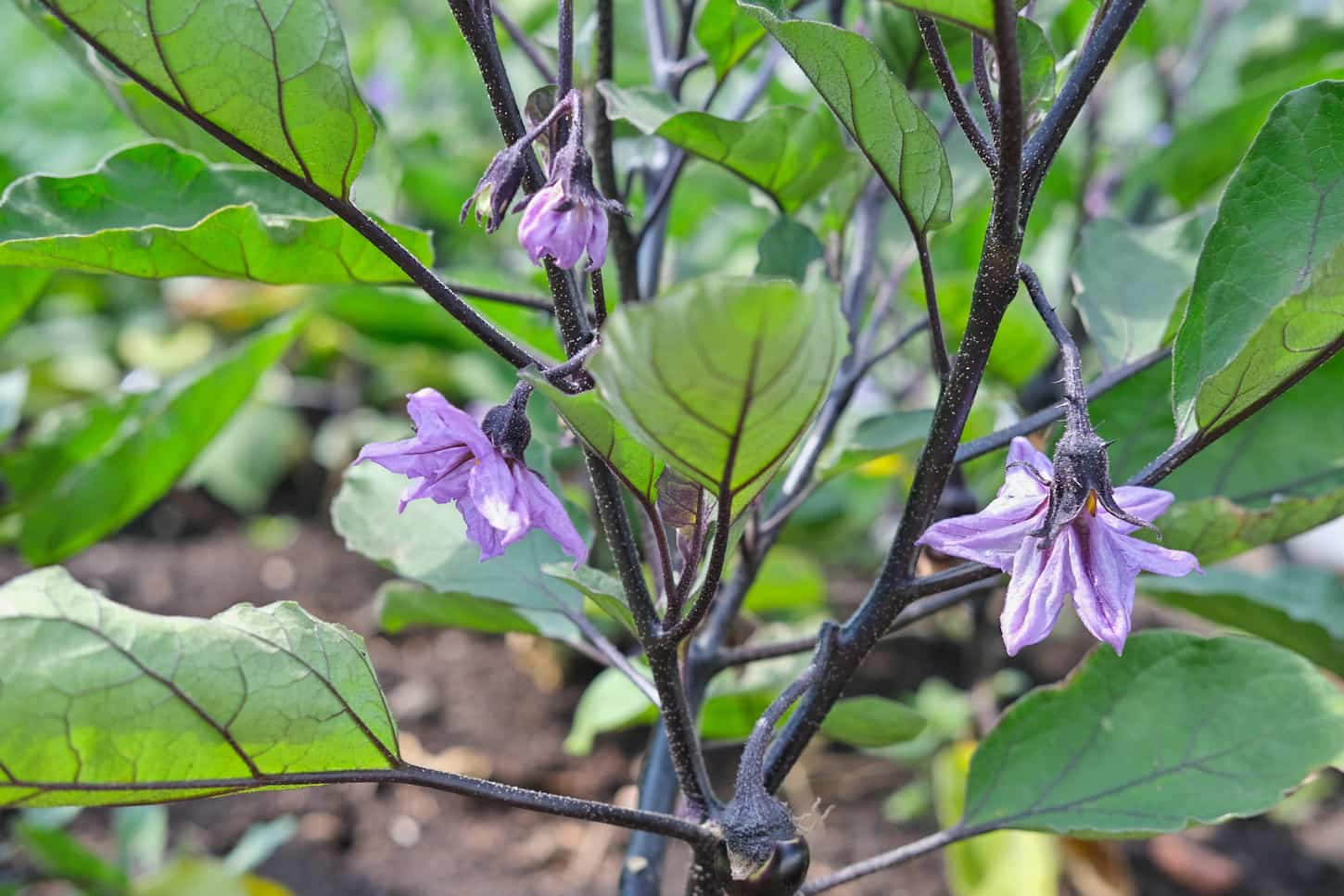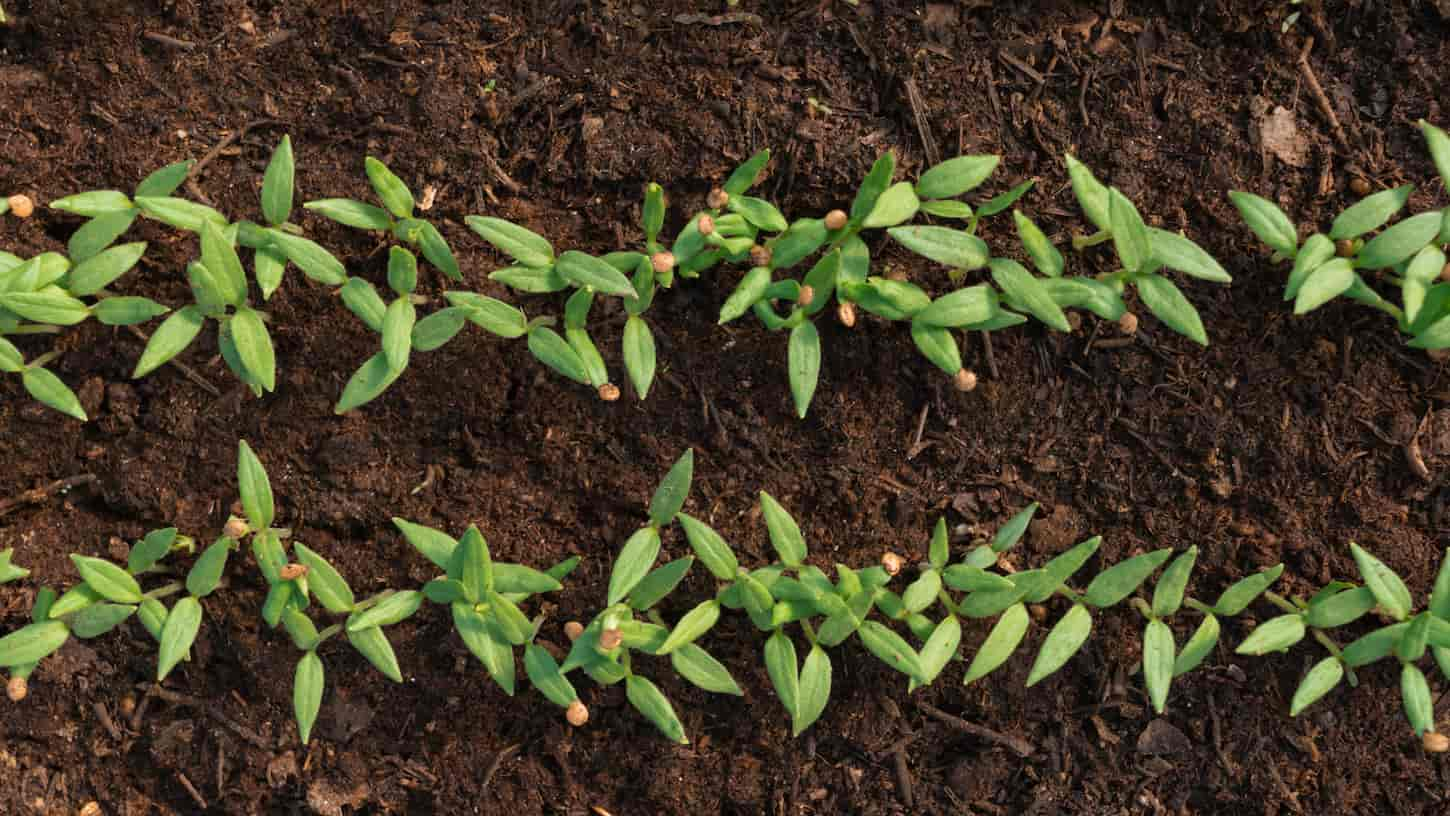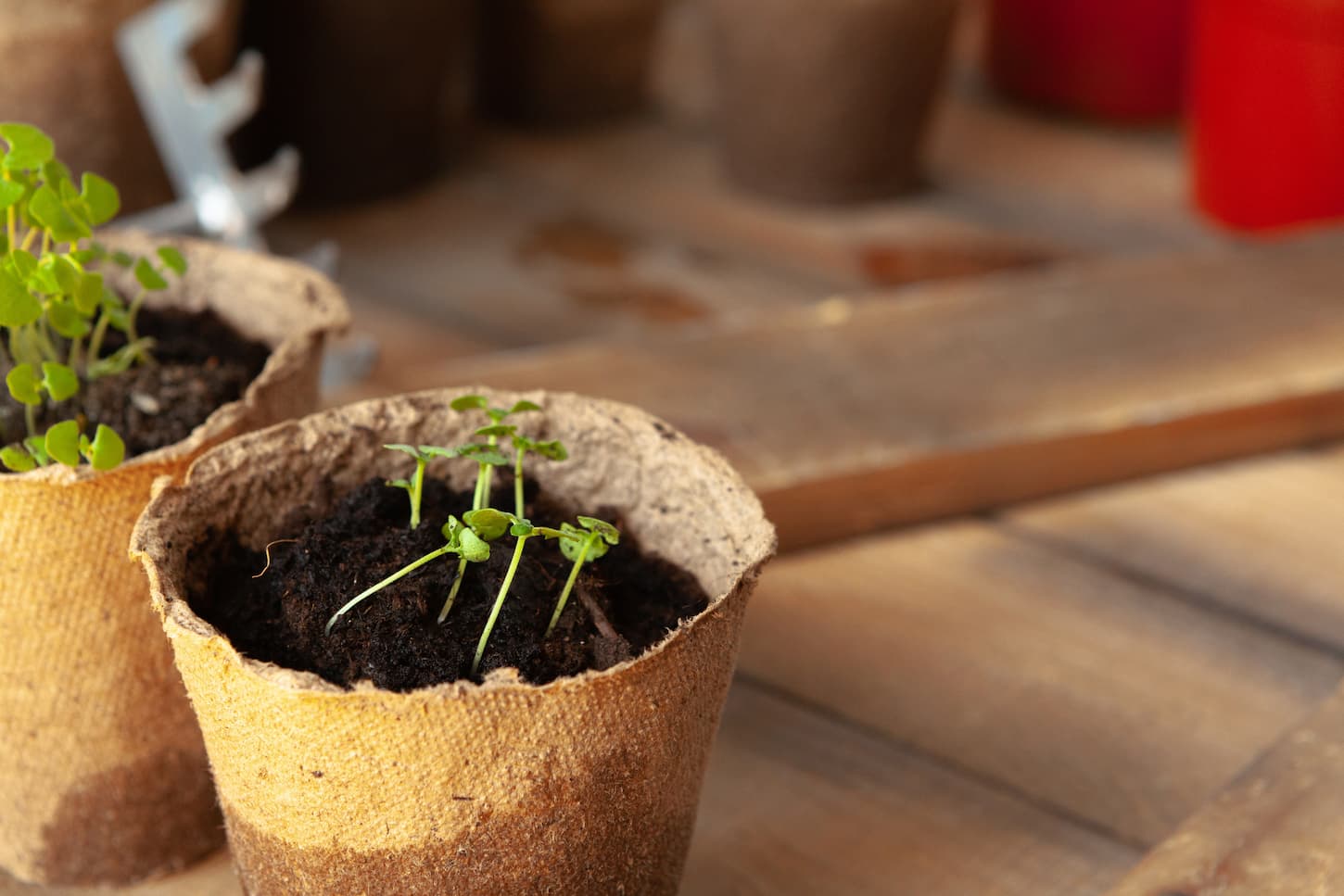Eggplants are heat-loving, tender, and perennial pear-shaped edibles that are generally thought of as vegetables but are actually a fruit. Grown by many home gardeners as annuals, these fruit crops are believed to have originated from India and are also known as Guinea squash, brinjals or aubergines.
Eggplants can be transplanted and buried up to about 60% to 65% of the depth of their stem if it’s a stalky seedling. Eggplants, like other nightshade plants including potatoes, peppers, and tomatoes, can be planted deeply as these plants can grow roots from their stems.
So, if there is any concern about the eggplant stems rotting in the soil due to deep planting, be assured that they’ll produce more roots. Nightshades benefit from a rich root system; this makes them healthier so that they will produce a larger crop. Let’s look into how to plant and grow eggplants.

How Deep Can You Plant Eggplant Seedlings?
Eggplant seedlings can be buried below their lowest leaves, though how deep eggplant seedlings should be planted actually depends on their size. Eggplant seedlings are typically tougher and stalkier, plus they have short stems, unlike tomatoes and peppers, so a planting depth of 1.25-2.25 inches should be just right.
In the case of a leggier or tall and thin eggplant seedling, they should be planted much deeper. A good rule of thumb is to bury about two-thirds of their stem in the soil after pruning the lower leaves. Seeds on the other hand should be planted ¼-½ of an inch deep into the soil.
The more roots the eggplants are able to develop, the better for their stability, strength, growth, and nutrient intake. Deep planting enables the eggplants to develop lots of roots and establish themselves in the soil properly.
When’s the Best Time to Plant Eggplants?
Eggplants should be grown in late spring, as this is the time of the year with the most favorable growing conditions for these cold-sensitive plants. During this period the weather is super warm and the dangers of frost would have passed.
It is very important that the eggplant seeds are started indoors, 8-10 weeks before the region’s last frost date. If working with a nursery start, make sure to buy it close to the growing season in order to increase the chances of growing a healthy and productive plant.
Additionally, eggplants require a soil pH of 5.5 to 6.8 to thrive and need to be subjected to a night temperature of about 70 to 90 degrees Fahrenheit for a little over two months for a successful harvest.
What Should You Not Plant Next to Eggplants?
In the bid to efficiently care for eggplants it’s a good idea to look at companion planting for better growth outcomes. Be careful about what is planted next to the eggplants, or harm may come to them. To keep this from happening, DO NOT plant fennel, geranium, corn, zucchini, and black walnuts.
If unfamiliar with the effects or impact of companion planting, here are a few suggestions that will help with understanding this practice better.
- Certain plants can emit signals or chemicals that may increase or interfere with the growth of nearby crops, while others attract pests away from neighboring plants. This is known as trap cropping.
- Some companion plants can be used as ground covers to checkmate nutrient competition, reduce weeds, and conserve water.
- Other plants can be used to attract pollinators to the garden or serve as a trellis for neighboring plants to grow on.
- Plants that are vulnerable need a larger companion plant to provide them with shade.
Good companion plants for eggplants include herbs like oregano, thyme, French tarragon, chamomile, rosemary, sage, lavender, marjoram, catnip, and dill. Mints such as spearmint and peppermint also make great companion plants.
Flowers like marigolds, sunflowers, nasturtium, snapdragons, and borage can be planted next to eggplants. Other companion plants include spinach, Swiss chard, kohlrabi, radishes, cabbage, pole beans, bush beans, lentils, peas, peppers, potatoes, and tomatoes.
The table below breaks down why some crops make great companion plants and why others don’t.
| Plants | Eggplant friendly | Reason |
|---|---|---|
| Fennel & black walnut | No | Allelopathic plants that can slow eggplants growth |
| Cabbage | Yes | Keeps pests away from eggplants by serving as a trap crop |
| Corn & Zucchini | No | Heavy feeders are just like eggplants and will compete for growth |
| Pole & bush beans | Yes | Legumes that can fix nitrogen into the soil |
| Geraniums | No | Host diseases eggplants are affected by |
| Oregano & thyme | Yes | Have strong smells that can repel pests |
| Peppers & tomatoes | Yes | Eggplants will grow well with other nightshades |
Eggplants are prone to pest attacks. Aphids, cutworms, flea beetles, and spider mites are insects that can cause damage to eggplants. If having a hard time keeping pests away from the eggplant, a trap crop or a pest-repelling plant as a companion plant would serve much better than any other shrub.

Why it’s Better to Start Eggplant Seeds Indoors
Starting eggplant seeds indoors or purchasing their nursery starts is the best way to establish eggplants before planting them outside in the garden. However, if living in an extremely warm, tropical, or humid region, eggplants can be grown directly from seeds in the garden.
Eggplants need to be supplied with consistently warm conditions for about 4 months to grow successfully. Start the eggplant seeds indoors and transplant them to the garden once the growing season starts. Or purchase their seedlings from a nursery close to the time when they will be planted.
When choosing nursery starts, please keep the following suggestions in mind:
- Wait until the soil is warm enough and the conditions are favorable before picking out a seedling. If buying a start early in the season, make sure to transplant them into gallon containers. Leave the seedlings out during the day and bring them inside at night.
- Choose a short and stalky seedling to ensure that its roots are not protruding from the drainage holes.
- Do not go for a nursery start with blossoms or fruit already formed, as these will produce a lower yield.
When growing the eggplant from seeds, here is how to start them indoors in 8 easy steps. First, I’ll list the steps, and then I’ll explain each of these steps in more detail.
- Soak eggplant seeds overnight.
- Sow the seeds ¼ -½ inch deep into the containers.
- It takes 8 to 10 days for an eggplant seed to sprout.
- Water eggplant seedlings consistently every week.
- Fertilize once every week with soluble fertilizers.
- Transplant the seedlings to separate pots.
- Set up supplemental light to promote sturdy growth.
- Harden up eggplant seedlings to prepare them for the outdoors.
Step 1: Soak eggplant seeds overnight to encourage successful germination. It’s important to start the seeds 8-10 weeks before the last frost and germinate them in an area that is super warm.
Step 2: Sow the seeds ¼ -½ inch deep into the containers. Vermiculite is an effective growing medium for these plants, alongside any other potting mix that enables water retention while allowing proper drainage of surplus moisture and covering the seeds lightly with soil mix.
Step 3: It takes 8 to 10 days for an eggplant seed to sprout; within this period a soil temperature of 75-80 degrees F should be maintained. Use heating cables, a dome, heat mats, or a cloche to achieve this. Another way to ensure the soil is kept warm is by covering the flats before sowing any seed.
Step 4: Water eggplant seedlings consistently every week to a depth of about an inch. Overhead watering can sometimes result in seeds washing deep into the soil mix, so a bottom watering system that uses capillary action to water the growing medium would be perfect for these young plants.
Step 5: Fertilize once every week with soluble fertilizers after seed germination two weeks after the eggplant seeds sprout. Apply about 1 tablespoon of soluble fertilizer to 4 liters of water and use it on the seedlings.
Step 6: Transplant the seedlings to separate pots. Once the eggplant seedlings grow up to 3 inches, transplant them to individual pots and keep transplanting them until the growing conditions outside are favorable.
Step 7: Set up supplemental light to promote sturdy growth. Once the seeds germinate it is imperative that lights are set up about 6 inches above the flats to keep them from getting leggy. Give them twelve to fourteen hours of light daily and lower the lights slowly as they grow.
Step 8: Harden up eggplant seedlings to prepare them for the outdoors. Reduce the frequency of watering, and the ambient temperature, and gradually expose seedlings to the outdoors since the eggplants can acclimatize to outdoor growing conditions.
When growing the eggplants in a container, make sure to choose a smaller growing variety. Turn up the heating system and feed them every 2 to 3 weeks with a dilute solution of fish emulsion or compost tea. The growing season can be easily extended by moving them indoors when there is frost.
You can hand pollinate plants by shaking them, using a cotton swab, a feather, or a small paintbrush to disperse pollen to each flower. Additionally, using peripheral lights is very important to successfully grow eggplants as houseplants.
While eggplants are edible, they are part of the toxic family of nightshades. So, keep them away from children and pets who might munch on them.

How to Plant Eggplant Starts
Most garden centers or nurseries sell eggplant starts. This makes sowing directly into the garden quite easy. However, It is best to let the seedlings sit out for a few more days in order to cancel out any chances of transplant shock.
As we hinted at previously, hardening of the eggplant seedlings is crucial before transplanting them to an outdoor space, but there are a few more things that need to be done to ensure a successful transplant.
Below is a summary of what needs to be done before planting the eggplant outside:
- Prune the lower leaves of the eggplant and get rid of any discolored leaves. Prune up to a quarter of the eggplants’ foliage. This not only encourages root development but also better plant growth.
- Pick all flower buds of the eggplant. At this stage it’s important to help the eggplant with developing roots, growing more leaves, and growing big so that it can support larger fruit. Discard flowers and continue to take them off the eggplants for at least two weeks.
- Water the eggplant thoroughly, as this will make uprooting super easy. Proper hydration is very crucial to these types of plants. A clear indicator that they don’t have enough water is when the flowers start to drop.
- Don’t tamper with the roots when uprooting – leave them as they are for a seamless transition. If work on the roots must be done, keep the touch-ups around the edges.
Now that we’ve gotten this out of the way, here’s a step-by-step guide on how to transplant the eggplant seedlings into the garden. Again, first comes the basic list and then the list with the details.
- Wait until the soil is warm enough.
- Dig a hole in the ground.
- Apply organic fertilizer to the bottom of the hole.
- Set the eggplant seedling into the hole.
- Firm up the soil around the plant and water gently.
- Support the eggplant with a stake or small tomato cage.
- Protect young transplants.
- Use polyethylene row covers or shading cloths if needed.
Step 1: Wait until the soil is warm enough. Before planting the seedlings, it’s important to wait for the soil to be warm enough. If you don’t want to wait for the natural frost season to pass, you can put a hardening box (or a cold frame or a portable greenhouse) out over the spot where you’ll plant your eggplants. This will help warm the soil safely and naturally.
Step 2: Dig a deep enough hole in the ground. Proceed to dig a hole for the eggplant 2 to 3 weeks after the last frost. Use the planting depth we specified in the first subheading for guidance through the process, then moisten the hole. While you’re watering things, go ahead and water the eggplant, too.
Step 3: Apply organic fertilizer to the bottom of the hole – a 5-10-5 or 5-10-10 fertilizer should do well. After applying the fertilizer, proceed to fill the hole lightly with planting mix or aged compost.
Step 4: Set the eggplant seedling into the hole. How deep the hole needs to be will depend on its size, so refer back to the first subheading for guidance through this step. If planting multiple eggplants, space them 24 to 36 inches apart.
Step 5: Firm up the soil around the plant and water gently. Then create a water-holding basin by forming a ridge of soil around the outer edge of the eggplant’s hole. This will help direct water to their roots.
Step 6: Support the eggplant with a stake or small tomato cage. Eggplants can tip over when they’re loaded with fruit, so staking or any other support system is very important to these plants.
Step 7: Protect young transplants. Don’t panic if the eggplants look a bit wilted or droopy a week after transplanting. As long as they were hardened off properly, they will recover.
Step 8: Use row covers or a shading cloth if needed. If the weather is still chilly, the eggplants will need to be protected with layers of horticultural fleece or polyethylene row covers. Using a tomato “wall of water” works, too. Excessive heat can also be a problem, and a quick fix for this is a shading cloth.
Expect to start harvesting the eggplants in 70 to 85 days if they were grown from transplants, and 100 to 150 days if they were started from seeds. They are best harvested young before their flesh becomes pithy. They are ready for harvest when they are firm, glossy, and full-colored.

Final Thoughts and Next Steps
If eggplants weren’t so prone to flea beetle attacks, they would be a very easy crop to grow. Beetles aside, if you can get them off to a good start, then it’s likely that a bountiful harvest and delicious flavorful meals will follow.
These plants can also be grown as ornaments. Popular decorative varieties include pumpkin on a stick (Solanum integrifolium) and the golden egg tree (Solanum melongena “Ovigerum”).
Eggplants make a great addition to any garden space because of their considerable health benefits and their visual appeal. Don’t forget that their foliage or leaves are toxic and are therefore inedible. With that said we hope this article was helpful, and best wishes for a successful crop.
As for the next step, getting your garden soil the right consistency so that your plants have the right level of drainage is hugely important for any gardener. That’s why you should give my article 11 Reasons Your Garden Soil Doesn’t Absorb Water (with 18 fixes!) a read next. That way, you’re ready to grow anything and everything in your garden.
Resources
Learning from your own experience is essential, but learning from others is also intelligent. These are the sources used in this article and our research to be more informed as homesteaders.
- Old Farmer’s Almanac. “Eggplants.” Old Farmer’s Almanac, www.almanac.com/plant/eggplants.
- Sim, Adriana. “Can You Bury the Eggplant Stems When Transplanting Them?” Tiny Garden Habit, Tiny Garden Habit, 26 Apr. 2021, www.tinygardenhabit.com/can-you-bury-the-eggplant-stems-when-transplanting-them/.
